Did you know that you can change the number of images you see by changing the angle two mirrors make with each other? Here’s how…
Please login or register to read the rest of this content.
Charles Benhamho (1895) created a toy top painted with the pattern (images on next page). When you spin the disk, arcs of color (called “pattern induced flicker colors”) show up around the disk. And different people see different colors!
We can’t really say why this happens, but there are a few interesting theories. Your eyeball has two different ways of seeing light: cones and rods. Cones are used for color vision and for seeing bright light, and there are three types of cones (red, green, and blue). Rods are important for seeing in low light.
One possibility is… Please login or register to read the rest of this content.
You already are familiar with what happens to an image on a plane mirror. What if the mirror is curved? Spherical mirrors are mirrors that are like a small section of a ball. (You could also argue that a plane mirror is a spherical mirror with an infinitely large radius, but let’s save that for another time…)
If you’ve never done this experiment, you have to give it a try! This activity will show you the REAL reason that you should never look at the sun through anything that has lenses in it.
Because this activity involves fire, make sure you do this on a flame-proof surface and not your dining room table! Good choices are your driveway, cement parking lot, the concrete sidewalk, or a large piece of ceramic tile. Don’t do this experiment in your hand, or you’re in for a hot, nasty surprise.
As with all experiments involving fire, flames, and so forth, do this with adult help (you’ll probably find they want to do this with you!) and keep your fire extinguisher handy.
Materials:
Here’s what you need to do:
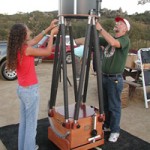 So you’ve played with lenses, mirrors, and built an optical bench. Want to make a real telescope? In this experiment, you’ll build a Newtonian and a refractor telescope using your optical bench.
So you’ve played with lenses, mirrors, and built an optical bench. Want to make a real telescope? In this experiment, you’ll build a Newtonian and a refractor telescope using your optical bench.
Materials:
In concave mirrors, the incident parallel light traveling parallel to the principal axis passes through the focal point when it reflects. Conversely, incident parallel light traveling through the focal point will then travel parallel when it reflects.
Reflection on a concave mirror uses two important basic rules: first, incident light traveling parallel to the principal axis passes through the focal point after it reflects on the surface. Second, incident light traveling through the focal point will travel parallel to the principle axis after it reflects.
Spherical mirrors have aberration, which is a loss in the definition of the image because of the geometry of the mirror itself. It’s a defect in the mirror shape itself, which is caused by not being able to focus all the light to a specific point.
Energy can take one of two forms: matter and light (called electromagnetic radiation). Light is energy that can travel through space. When you feel the warmth of the sun on your arm, that’s energy from the sun that traveled through space as infrared radiation (heat). When you see a tree or a bird, that’s light from the sun that traveled as visible light (red, orange… the whole rainbow) reflecting and bouncing off objects to get to your eye. Light can travel through objects sometimes… like the glass in a window.
You can see objects because light from that object travels to your eyes. Sometimes light is reflected off objects before it reaches our eyes, and sometimes it comes straight from the source itself.
A candle is a light source. So is a campfire, a light bulb, and the sun. An apple, however, reflects light. It doesn’t give off any light on its own but you can see it because light waves bounce off the apple into your eye. If you shut off the light, then you can’t see the apple. In this same way, the sun is a light source, and the moon is a light reflector.
Please login or register to read the rest of this content.
This simple activity has surprising results! We’re going to bend light using plain water. Light bends when it travels from one medium to another, like going from air to a window, or from a window to water. Each time it travels to a new medium, it bends, or refracts. When light refracts, it changes speed and wavelength, which means it also changes direction.
Diffraction happens when light goes around obstacles in its path. Sound waves diffract bend around obstacles, so if you’re stuck behind a pillar at a concert, you can still hear just fine.
Ever play with a prism? When sunlight strikes the prism, it gets split into a rainbow of colors. Prisms un-mix the light into its different wavelengths (which you see as different colors). Diffraction gratings are tiny prisms stacked together.
When light passes through a diffraction grating, it splits (diffracts) the light into several beams traveling at different directions. If you’ve ever seen the ‘iridescence’ of a soap bubble, an insect shell, or on a pearl, you’ve seen nature’s diffraction gratings.
Scientist use these things to split incoming light so they can figure out what fuels a distant star is burning. When hydrogen burns, it gives off light, but not in all the colors of the rainbow, only very specific colors in red and blue. It’s like hydrogen’s own personal fingerprint, or light signature.
Astronomers can split incoming light from a star using a spectrometer (you can build your own here) to figure out what the star is burning by matching up the different light signatures.
Materials:
Here’s what you do: Take a feather and put it over an eye. Stare at a light bulb or a lit candle. You should see two or three flames and a rainbow X. Shine a flashlight on a CD and watch for rainbows. (Hint – the tiny “hairs” on the feather are acting like tiny prisms… take your homemade microscope to look at more of the feather in greater detail and see the tiny prisms for yourself!
What happens when you aim a laser through a diffraction grating? Here’s what you do:
Materials:
Download Student Worksheet & Excercises
Exercises
Do you have thick or thin hair? Let’s find out using a laser to measure the width of your hair and a little knowledge about diffraction properties of light. (Since were using lasers, make sure you’re not pointing a laser at anyone, any animal, or at a reflective surface.)
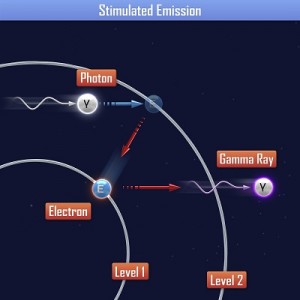 Have you ever wondered why you just can’t just shine a flashlight through a lens and call it a laser? It’s because of the way a laser generates light in the first place.
Have you ever wondered why you just can’t just shine a flashlight through a lens and call it a laser? It’s because of the way a laser generates light in the first place.
The word LASER is an acronym for Light Amplification by Stimulated Emission of Radiation.
That’s a mouthful. Let’s break it down.
Let’s do an experiment that shows you how a laser is different from light from a flashlight by looking at the wavelengths that make up the light.
Lasers light is different from light from a flashlight in a couple of different ways. Laser light is monochromatic, meaning that it’s only one color.
Laser light is also coherent, which means that the light is all in synch with each other, like soldiers marching in step together. Since laser light is coherent, which means that all the light waves peaks and valleys line up. The dark areas are destructive interference, where the waves cancel each other out. The areas of brightness are constructive interference, where the light adds, or amplifies together. LED light is not coherent because the light waves are not in phase.
Polarization has to do with the direction of the light. Think of a white picket fence – the kind that has space between each board. The light can pass through the gaps int the fence but are blocked by the boards. That’s exactly what a polarizer does.
When you have two polarizers, you can rotate one of the ‘fences’ a quarter turn so that virtually no light can get through – only little bits here and there where the gaps line up. Most of the way is blocked, though, which is what happens when you rotate the two pairs of sunglasses. Your sunglasses are polarizing filters, meaning that they only let light of a certain direction in. The view through the sunglasses is a bit dimmer, as less photons reach your eyeball.
Polarizing sunglasses also reduce darken the sky, which gives you more contrast between light and dark, sharpening the images. Photographers use polarizing filters to cut out glaring reflections.
Materials:
The electromagnetic spectrum shows the different energies of light and how the energy relates to different frequencies. The wavelength (λ) equals the speed of light (c) divided by the frequency (ν), or λ = c / ν. The speed of light is: c = 3 x 108 m/s (300,000,000 meters per second).
Do you see where the “visible light” rainbow section is in the electromagnetic spectrum image below? This small area shows the light that you can actually see with your eyeballs. Note that the “rainbow of colors” that make up our entire visible world only make up a small part of all the light, from 400-700 nm (nanometers, or 10-9.
Please login or register to read the rest of this content.
You can demonstrate the primary colors of light using glow sticks! When red, green, and blue cold light are mixed, you get white light. Simply activate the light stick (bend it until you hear a *crack* – that’s the little glass capsule inside breaking) and while wearing gloves, carefully slice off one end of the tube with strong cutters, being careful not to splash (do this over a sink).
Please login or register to read the rest of this content.
Is white or black a color? No and no. White is the mixture of all the colors (red, orange, yellow, green, blue indigo, and violet), so technically white isn’t a color of light but rather the combination of colors. Black is also not technically a color. In outer space, it’s pitch-black dark because there’s no light. In a room with the lights off, it’s also black. Black is the absence of color.
When you change the wavelength, you change the color of the light. If you pass a beam white light through a glass filled with water that’s been dyed red, you’ve now got red light coming out the other side. The glass of red water is your filter. But what happens when you try to mix the different colors together?
Your eyes have two different light receptors located on the back of the eyeball. These are the rods, which see black, white and grays can detect different intensities. The cones can detect color when the light strikes the cells that have a color-sensing chemical reaction that gets activated and sends a pulse to the brain. There are three cones: red, which can detect red wavelengths and some orange and yellow, green cones (which can also detect blue and yellow) are the most sensitive to light, and blue cones.
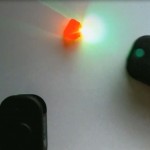 Gummy bears are a great way to bust one of the common misconceptions about light reflection. The misconception is this: most students think that color is a property of matter, for example if I place shiny red apple of a sheet of paper in the sun, you’ll see a red glow on the paper around the apple.
Gummy bears are a great way to bust one of the common misconceptions about light reflection. The misconception is this: most students think that color is a property of matter, for example if I place shiny red apple of a sheet of paper in the sun, you’ll see a red glow on the paper around the apple.
Where did the red light come from? Did the apple add color to the otherwise clear sunlight? No. That’s the problem. Well, actually that’s the idea that leads to big problems later on down the road. So let’s get this idea straightened out.
Have you ever wondered why the sky is blue? Or why the sunset is red? Or what color our sunset would be if we had a blue giant instead of a white star? This lab will answer those questions by showing how light is scattered by the atmosphere.
Lasers light is different from light from a flashlight in a couple of different ways. Laser light is monochromatic, meaning that it’s only one color.
Imagine you have a coherent light in a shoebox, and you cut two narrow slits out the side and shine the light on the far wall. The distance from one slit to the wall isn’t going to be exactly the same as the other, so there’s a “path difference”.
We’re going to use a laser pointer and a protractor to measure the microscopic spacing of the data tracks on a DVD and a CD. The really cool part is that you’re going to use an interference pattern to measure the spacing of the tracks, something that you can’t normally see with your eyes.
This experiment is also known as Young’s Experiment, and it demonstrates how the photon (little packet of light) is both a particle and a wave, and you really can’t separate the two properties from each other. If the idea of a ‘photon’ is new to you, don’t worry – we’ll be covering light in an upcoming unit soon. Just think of it as tiny little packets or particles of light. I know the movie is a little goofy, but the physics is dead-on. Everything that “Captain Quantum” describes is really what occurred during the experiment. Here’s what happened…
To show how light acts like a wave, you can pass light through a glass of water and watch the rainbow reflections on the wall. Why does this happen? We’ve already covered this in a previous lesson, but basically when the light passes through the glass and the water, it bends to give different frequencies of light and therefore different colors.
Please login or register to read the rest of this content.
This is a recording of a recent live teleclass I did with thousands of kids from all over the world. I’ve included it here so you can participate and learn, too!
Sound is a form of energy, and is caused by something vibrating. So what is moving to make sound energy?
Molecules. Molecules are vibrating back and forth at fairly high rates of speed, creating waves. Energy moves from place to place by waves. Sound energy moves by longitudinal waves (the waves that are like a slinky). The molecules vibrate back and forth, crashing into the molecules next to them, causing them to vibrate, and so on and so forth. All sounds come from vibrations.
Materials:
A sound wave is different from a light wave in that a sound is a mechanical wave, which requires particle interaction in order to exist. Light waves can travel in the vacuum of space, and we’ll talk more about this in our next section when we get to light.
Think of your ears as ‘sound antennas’. There’s a reason you have TWO of these – and that’s what this experiment is all about. You can use any noise maker (an electronic timer with a high pitched beep works very well), a partner, a blindfold (not necessary but more fun if you have one handy), and earplugs (or use your fingers to close the little flap over your ear – don’t stick your fingers IN your ears!).
Sound is a type of energy, and energy moves by waves. So sound moves from one place to another by waves; longitudinal waves to be more specific. So, how fast do sound waves travel? Well, that’s a bit of a tricky question. The speed of the wave depends on what kind of stuff the wave is moving through. The more dense (thicker) the material, the faster sound can travel through it.
When something vibrates, it pushes particles. These pushed particles create a longitudinal wave. If the longitudinal wave has the right frequency and enough energy, your ear drum antennas will pick it up and your brain will turn the energy into what we call sound. The higher the amplitude, the more energy the wave has. Intensity of a measure of a wave’s power per unit area, and is measured in Watts per square meter.
It may seem like walking across a balance beam and listening to your favorite song are very different activities, but they both depend on your ears. Ears are the sense organs that control hearing, which is the ability to detect sound. Ears also sense the position of the body and help maintain balance when you walk a balance beam or ride a bike.
Imagine a pebble being dropped into a lake. Waves of water go off in all directions. A similar thing happens when a car driving down the street honks its own. Waves go off from the car in all direction. The difference is that these are not waves of water, but instead are sound waves, which travel through the air. If you are nearby, some of those sound waves make it to your ear.
Here’s a video that shows you how everything works together so you can hear:
The pinna, or outer ear, which is the part of your ear that you can see, gathers up some of the sound waves, sends them down the ear canal, and eventually they strike the eardrum. The eardrum is a thin membrane that vibrates like a drum when the waves hit it. The vibrations pass three tiny bones, called the hammer, anvil, and stirrup, as well as a membrane called the oval window, causing them all to vibrate.
From the oval window, the vibrations go to the cochlea, liquid-filled space lined with hairs. The vibrations make waves in the cochlea’s liquid, just like waves in a pond, causing the hairs to move. The movement of the hairs sends a nerve impulse through the auditory nerve to the brain. The brain interprets the message and “tells” you what you have heard.
This video is an old instructional film shown to pre-med students in the early 50s you might enjoy watching:
Along with hearing, the ears play a major role in balance. Inside the ears are semicircular canals which are lined with hairs and full of liquid. When the body moves in one direction, the liquid in the semicircular canals move, causing the hairs to move. This sends a message to your brain, which gives instructions for the body’s muscles to contract or relax. This keeps you balanced.
There’s a cool video of a camera going inside the ear… watch out for the wax!
How do you think animals know we’re around long before they see us? Sure, most have a powerful sense of smell, but they can also hear us first. In this activity, we are going to simulate enhanced tympanic membranes (or ear drums) by attaching styrofoam cups to your ears. This will increase the number of sound waves your ears are able to capture.
Have you ever been in a thunders storm? Here’s how you can use wave speed to figure out how far away that lightning strike really was.
Although the speed of a wave is found by multiplying the frequency by the wavelength, it’s important to note that the wave speed doesn’t change if you change the wavelength or frequency. What actually happens is that if you change the frequency, you also change the wavelength so the wave speed will remain constant. The speed of the wave depends only on the properties of the medium it’s traveling through, so the only way to change the wave speed is to change the properties of the medium itself.
Let’s review interference and nodes for a minute…
How waves interact with each other depends on whether the waves are in phase or not. If they are in-step (in phase) with each other, then it’s easy to add up to double the displacement (constructive interference). If they are completely out of step, then they cancel each other out (destructive interference). We’ve seen this for transverse waves, but what about compression waves, like for sound waves?
Destructive interference happens when a compression and rarefaction section meet and the next effect is that there’s no push or pull on the particles. The waves don’t destroy each other (as the name implies), but rather they cancel out the effect of each other when they interact with each other, which results in no sound at all. Which is kind of odd to think about: two sound waves interacting to make no sound at all. This happens at the nodes, where there’s no particle displacement.
Beats refers to the pattern that two similar waves make when they interfere with each other. A beat pattern is one that varies in volume (amplitude) as the waves constructively and destructively interfere with each other. The beat frequency is the wave that forms when you hear the volume go from high to low volume.
The Doppler Effect describes how moving sound waves can shift frequencies for either the observer, the source, or both, depending on the motion of each. You’ll find Doppler shifts with waver, sound, and light waves. For sound waves, if the source is moving toward the observer, the observer will hear higher pitch sounds. And if the source moves away from the observer, then they will hear lower pitch sounds. The frequency at the source didn’t change, only what the observer perceives is difference because there’s motion between them. It’s a shift in the apparent frequency.
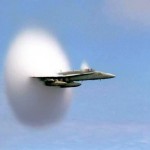 Sound can change according to the speed at which it travels. Another word for sound speed is pitch. When the sound speed slows, the pitch lowers. With clarinet reeds, it’s high. Guitar strings can do both, as they are adjustable. If you look carefully, you can actually see the low pitch strings vibrate back and forth, but the high pitch strings move so quickly it’s hard to see. But you can detect the effects of both with your ears.
Sound can change according to the speed at which it travels. Another word for sound speed is pitch. When the sound speed slows, the pitch lowers. With clarinet reeds, it’s high. Guitar strings can do both, as they are adjustable. If you look carefully, you can actually see the low pitch strings vibrate back and forth, but the high pitch strings move so quickly it’s hard to see. But you can detect the effects of both with your ears.
When waves go from air to water, they must pass through a boundary between the two, and depending on the properties of two mediums, the wave will do one (or more) of four possible behaviors: reflect, diffract, transmit transmit through, and/or refract.
Everything is vibrating. Absolutely everything is wiggling and jiggling, and most of those things are doing it really fast! Now, I can hear you saying “Hey…maybe you need to check your eyesight or lay off the coffee because in my house, I’m not seeing everything jiggling.”
You can easily make a humming (or screaming!) balloon by inserting a small hexnut into a balloon and inflating. You can also try pennies, washers, and anything else you have that is small and semi-round. We have scads of these things at birthday time, hiding small change in some and nuts in the others so the kids pop them to get their treasures. Some kids will figure out a way to test which balloons are which without popping… which is what we’re going to do right now.
This is one of my absolute favorites, because it’s so unexpected and unusual… the setup looks quite harmless, but it makes a sound worse than scratching your nails on a chalkboard. If you can’t find the weird ingredient, just use water and you’ll get nearly the same result (it just takes more practice to get it right). Ready?
NOTE: DO NOT place these anywhere near your ear… keep them straight out in front of you.
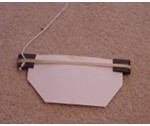 Sound is everywhere. It can travel through solids, liquids, and gases, but it does so at different speeds. It can rustle through trees at 770 MPH (miles per hour), echo through the ocean at 3,270 MPH, and resonate through solid rock at 8,600 MPH.
Sound is everywhere. It can travel through solids, liquids, and gases, but it does so at different speeds. It can rustle through trees at 770 MPH (miles per hour), echo through the ocean at 3,270 MPH, and resonate through solid rock at 8,600 MPH.
Sound is made by things vibrating back and forth, whether it’s a guitar string, drum head, or clarinet. The back and forth motion of an object (like the drum head) creates a sound wave in the air that looks a lot like a ripple in a pond after you throw a rock in. It radiates outward, vibrating it’s neighboring air molecules until they are moving around, too. This chain reaction keeps happening until it reaches your ears, where your “sound detectors” pick up the vibration and works with your brain to turn it into sound.
You can illustrate this principle using a guitar string – when you pluck the string, your ears pick up a sound. If you have extra rubber bands, wrap them around an open shoebox to make a shoebox guitar. You can also cut a hole in the lid (image left) and use wooden pencils to lift the rubber band off the surface of the shoebox.
 When a guitarist plucks a string to start the vibration, it not only vibrates the string, but it also vibrates the entire box of the guitar. This is called a forced vibration, which means that the motion of the original source vibration is also causing another object to vibrate (the box of the guitar). Since the box is larger than the string, it amplifies the vibration and makes it louder.
When a guitarist plucks a string to start the vibration, it not only vibrates the string, but it also vibrates the entire box of the guitar. This is called a forced vibration, which means that the motion of the original source vibration is also causing another object to vibrate (the box of the guitar). Since the box is larger than the string, it amplifies the vibration and makes it louder.
An electrical signal (like music) zings through the coil (which is also allowed to move and attached to your speaker cone), which is attracted or repulsed by the permanent magnet. The coil vibrates, taking the cone with it. The cone vibrates the air around it and sends sounds waves to reach your ear. Here’s how speakers work and also how to make your own out of cardboard (it really works!):
We’ve already looked at standing wave patterns that are created when a reflected wave interferes with an incoming wave. It looks like the wave is fluctuating in place, when really it’s just an optical illusion of two waves interfering with each other. The point is, this effect are created at specific frequencies called harmonics, and now it’s time to learn about vibrational modes using a really cool experiment by Ernst Chladni.
A vibrational mode is the standing wave pattern that give the highest amplitude vibrations with the least amount of energy input. If you vibrate an object at it’s natural frequency, you’ll get the highest amplitude during the vibration. Sometimes the amplitude (which is related to the energy of the vibration) that the object vibrates at is so high that the object will actually will tear itself apart. Here’s a video where the wind was blowing the bridge, which started a natural vibration in the bridge which tore itself apart.
Ella Fitzgerald was famous for breaking the wineglass with her voice at the end of the Memorex commercial:
Let’s see this in slow motion using lab equipment (video courtesy of MIT):
There are four general categories of musical instruments: guitars and pianos are examples of vibrational strings, trombones and flutes are examples of the open-and air column instruments, organ pipes are examples of the closed-end air instruments, and drums are examples of vibrational mechanical instruments.
When you blow into the mouthpiece of an instrument, the vibrations create frequencies, and the ones that resonate with the air in the tube inside the instrument are the ones you hear as a loud sound. When an instrument is open at both ends, it’s called an open-end air column. Here’s how to figure out the frequencies of these types of instruments:
Have you ever blown across a glass bottle? If so, you’ve played one of these instruments! Pipe organs are also closed-end air instruments because one end is sealed. The difference in sealing one end affects the types of frequencies that the instrument can create because the standing wave pattern that is created is from the incident (incoming) waves interfering with the reflected waves bouncing back when they hit the sealed end of the instrument.
Have you ever put a cardboard tube up to your ear? What you hear depends on whether the tube is right up against your ear or offset so there’s a space between your head and the tube, because it goes from being a closed end to an open end air column, which changes the standing wave pattern inside. Here’s how to figure it out:
Once upon a time, people used record players to hear music. Records were these big black discs that played on a machine. Spinning between 33 and 45 times per minute on a turntable, people used to listened to music just like this for nearly a century.
Edison, who had trouble hearing, used to bite down hard on the side of his wooden record player (called a phonograph) and “hear” the music as it vibrated his jaw.